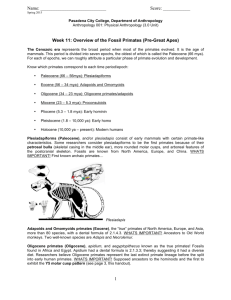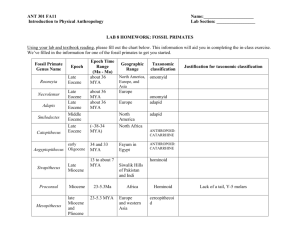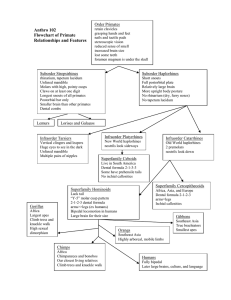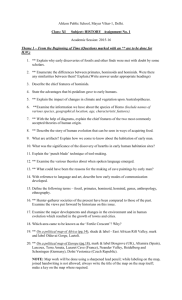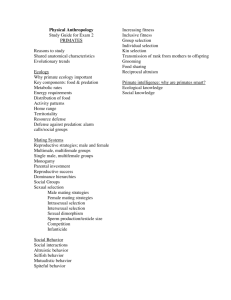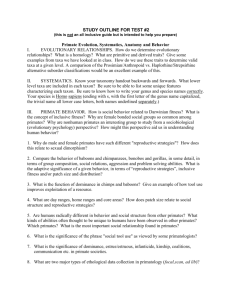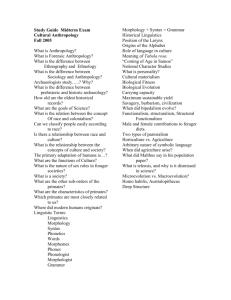Lecture: Primate Evolution
advertisement
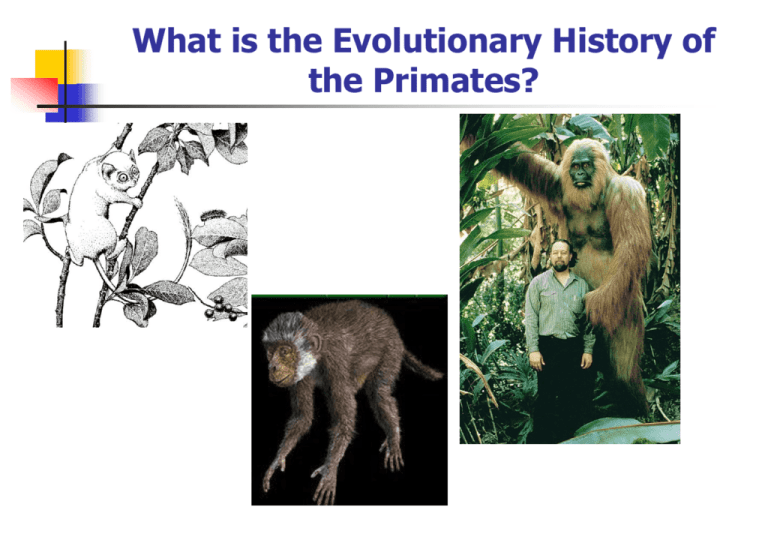
What is the Evolutionary History of the Primates? Cenozoic Timescale What is the Evolutionary History of the Primates? 1. EOCENE 54-38 mya Prosimian Radiations 2 exs: Smilodectes, Necrolemur 2. OLIGOCENE 38-23 mya Monkey Radiations 2 exs: Apidium, Aegyptopithecus 3. MIOCENE 23-5 mya Ape Radiations 2 exs: Sivapithecus, Gigantopithecus, Sahelanthropus Late Cretaceous Primate-like Mammal Purgatorius Last Common Ancestor: lived sometime in the late Cretaceous when dinosaurs still dominant land-dwelling life form [genetic evidence & diversity of primates from the Eocene and later] • However, fossils of true primates are not known until approximately 50 mya during the Eocene • During the late Cretaceous (>65 mya), ancestral shrew-like mammals show certain dental and limb bone features reminiscent of true primates Primate Origins If the last common ancestor of living primates did indeed live between 80 and 90 mya, the primate lineage that we are descended from would be pushed back more than 30 million years! New Discoveries of Early Primates New discoveries from Eocene of China reveal an unexpected diversity of early primates • Some ancestors of monkeys, apes and humans were so tiny that they could have stood atop a person’s thumb • Fossilized foot bones from 2 species smaller than any other known creature on the primate family tree were found at a limestone mine in Eastern China, bones each about the size of a grain of rice! Eocene Primates (Prosimian radiations) 1. Smilodectes (North America) Like modern lemurs it: • was hind-limbed dominated, indicating ability to leap long distances • had hands & feet w/nails • had supple, flexible spine Unlike modern lemurs it: • had generalized dentition lacking toothcomb, but retained large canines • had fused lower jaw • shortened muzzle Eocene Primates 2. Necrolemur (Europe) Very similar to the modern tarsier. Its features included: • Elongated ankle bones similar to those seen in Tarsius, indicative of clinging & leaping • Reduced snout and enlarged orbits, indicative of nocturnal adaptation • More generalized dentition showing adaptations for insect eating • Ears and eyes like modern tarsiers, but may have retained a wet nose Necrolemur Tarsius Oligocene Primates: Anthropoids (Monkey radiations) Anthropoids most likely branched off from the prosimians much earlier than previously thought. Their distinguishing features are: Eyes rotated more forward compared to prosimians Fully enclosed bony eye socket Dry nose separate from the upper lip Relatively low crowned, squared off chewing teeth Oligocene Primates: El Fayum, Egypt • • • Over the last 40 years, Anthropologists have excavated a fossil rich oasis in Egyptian Saharan desert called the Fayum depression Late Eocene & Oligocene = the Fayum was a lush tropical environment crisscrossed by myriad streams and rivers Diverse & abundant mammals Oligocene Primates 1. Apidium • Dental formula of 2:1:3:3 on both upper and lower jaws as in New World monkeys • Short snout & small eyes suggest that this was a diurnal species • Postorbital closure • Platyrrhine-like skeleton Oligocene Primates 2. Aegyptopithecus Face Aegyptopithecus, just after discovery in the river channel sands of the Fayum, about 32 mya lies somewhere near the base of the family tree of Old World monkeys, apes and humans generalized arboreal quadruped, with different sized sexes, traveled through ancient Egyptian jungles in small multimale, multi-female troops, diet thought to have been mainly fruits and leaves Aegyptopithecus Oblique View Aegyptopithecus Lateral View Miocene Primates (Ape radiations) 1. Sivapithecus •Discovered in Pakistan •Most anthropologists convinced of its relationship to the Orangutan (left) •Points of resemblance to modern Orangs: 1. Deep, concave face with large front teeth 2. Narrow distance between the eye orbits 3. Oval shape eye orbits 4. Pear-shaped nasal opening 5. Rim of bone around the upper margin of the orbits Miocene Primates 2. Gigantopithecus Largest primate that ever lived, thought by some to stand over 10’ tall and weigh close to 1200 lbs. Died out around 400,000 ya, may have coexisted with Homo erectus Some people believe it is still alive today as the yeti and bigfoot •These three lower jaws are twice the size of a Gorilla’s •most complete specimens known, discovered in a limestone cavern in China in 1956 Miocene Primates 3. Sahelanthropus • Discovered in Chad (6-7 mya) • Most complete cranium from this period of time & GREAT value in understanding last common ancestor of African apes & humans • Mosaic of ape & human-like features, but is at the “ape grade” of evolution • Features include: • Ape-like cranial capacity (320-380 cc) • Ape-like narrow U-shaped upper jaw • Very wide distance between the orbits • Large, thick continuous brow ridge • Human-like flat face • Human-like dentition Ecological Reconstruction • Mammals found in association with Sahelanthropus are Eurasian and African forms that indicate migration into Africa • Migration probably due to colder & drier climate in Eurasia • Late Miocene apes occur for the most part in Europe and Asia: several of these species may be hominid ancestors • The species could have arisen in Africa, but also possible that its lineage originated in Europe or Asia

